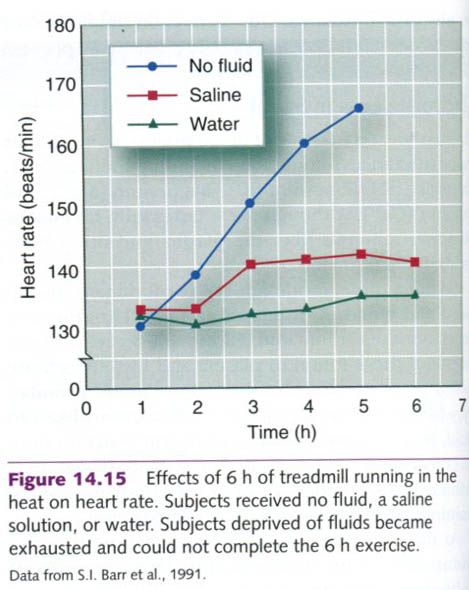Thirst
When people feel thirsty, they drink. The
thirst sensation is regulated by the hypothalamus. It triggers thirst when the
plasma’s osmotic pressure is increased. Unfortunately, the body’s thirst mechanism doesn’t precisely
gauge its state of dehydration. It does not sense thirst until well after
dehydration begins. Even when dehydrated, people might desire fluids only at
intermittent intervals.
The control of thirst is not fully understood.
When permitted to drink water as their thirst dictates, people can require 24
to 48h to completely replace water lost through heavy sweating. In contrast,
dogs and burros can drink up to 10% of their total body weight within the first
few minutes after exercise or heat exposure, replacing all lost water. Because
of our sluggish drive to replace body water and to prevent chronic dehydration,
we are advised to drink more fluid than our thirst dictates. Because of the
increased water loss during exercise, it is imperative that athletes’ water
intake be sufficient to meet their bodies’ needs, and it is essential that they
rehydrate during and after an exercise bout.
Benefits of fluids during exercise
Drinking fluids during prolonged exercise,
especially in hot weather, has obvious benefits. Water intake will minimize
dehydration, increases in body temperature, cardiovascular stress, and declines
in performance. As seen in the figure below, when subjects became dehydrated
during several hours of treadmill running in the heat(40°C, or 104°F) without
fluid replacement, their heart rates increased steadily throughout the
exercise. When they were deprived of fluids, the subjects became exhausted and
couldn’t complete the 6h exercise. Ingesting either water or a saline solution
in amounts equal to weight loss prevented dehydration and kept subjects’ heart
rates lower. Even warm fluids(near body temperature) provide some protection
against overheating, but cold fluids enhance body cooling because some of the
deep body heat is used to warm cold drinks to body temperature.
Hyponatremia
Fluid replacement is beneficial, but too much
of a good thing could potentially be bad. In the 1980s, the first cases of
hyponatremia were reported in endurance athletes. Hyponatremia is clinically defined as a serum sodium concentration
below the normal range of 135 to 145 mmol/L. Symptoms of hyponatremia generally
appear when serum sodium levels drop below 130 mmol/L. Early signs and symptoms
include bloating, puffiness, nausea, vomiting, and headache. As the severity
increases, due to increasing cerebral edema(swelling of the brain), the
symptoms include confusion, disorientation, agitation, seizures, pulmonary
edema, coma, and death. How likely is hyponatremia to occur?
The processes that regulate fluid volumes and
electrolyte concentrations are highly effective, so consuming enough water to
dilute plasma electrolytes is difficult under normal circumstances. Marathoners
who lose 3 to 5 L of sweat and drink 2 to 3 L of water maintain normal plasma
concentrations of sodium, chloride, and potassium.
And distance runners who run 25 to 40 km(15.5-24.9 mi) per day in warm weather
and do not salt their food don’t develop electrolyte deficiencies.
Some research has suggested that during
ultramarathon running(more than 42 km, or 26.2 mi), athletes can experience
hyponatremia. A case study of two runners who collapsed after an ultramarathon
race(160km, or 100 mi) in 1983 revealed that their blood sodium concentrations had decreased from a normal value of
140 mmol/L to values of 123 and 118 mmol/L. One of the runners experienced a
grand mal seizure; the other became disoriented and confused. Examining the
runners’ fluid intakes and estimating their sodium intakes during the run
suggested that they had diluted their sodium contents by consuming too much
fluid that contained too little sodium.
The ideal resolution to prevent hyponatremia
would be to replace water at the exact rate at which it is being lost or to add
sodium to the ingested fluid. The problem with the latter approach is that the
most sport drinks contain no more than 25 mmol/L of sodium and are apparently
too weak to prevent sodium dilution alone, but very strong concentrations
cannot be tolerated. Exercise hyponatremia appears to be the result of a fluid
overload due to overconsumption, underreplacement of sodium losses, or both.
Only a small number of cases have been reported. Thus, it is probably
inappropriate to form conclusions from this information to design a fluid
replacement regimen for people who must exercise for long periods in the heat.










0 коментара:
Постави коментар